

The best diving in NSW
Scuba diver exploring the soft coral reef at the Cook Island dive site, Fingal Head



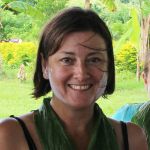
Dive Expert Deborah Dickson-Smith
Discover an incredible array of marine life at diving sites along the NSW coast. Dive with seals, explore shipwrecks and swim through caves at these incredible scuba diving sites.
Home to the largest fur seal colony on the NSW coast, Montague Island is also a breeding ground for around 15 bird species – while dolphins, humpback whales and grey nurse sharks can all be seen at various times of year. For divers, it’s the seals that are the star of the underwater show here.
During the cooler months, dive with up to 1,800 fur seals as well as pods of dolphins; listen out for whale song from migrating humpbacks. Most seals frolic in water between three to 15m deep, making this an accessible experience for divers of all levels.
As summer approaches, warmer currents bring with them tropical fish and the nutrients that feed the coral, nudibranchs, giant tube worms and gorgonian fans. The currents also bring creatures not normally seen this far south, such as grey nurse sharks that take up residence in February, the occasional turtle, and even mantas and sunfish. Around 200 to 500 seals stay around for the summer months.
In addition to seals, you’ll encounter various rays and numerous fish species, including wobbegong and Port Jackson sharks, eastern blue gropers, fiddler rays, nudibranchs and moray eels.

Seal swimming at Montague Island near Narooma
Jervis Bay is famous for having ‘the whitest sand in the world’, but it’s the underwater world in the Jervis Bay Marine Park that makes it one of the most popular diving destinations on the NSW Coast. The marine reserve spans 100km of coastline, with more than 50 dive sites to choose from, each one teeming with life.
The topography of the bay is dramatic above and below water, with imposing cliffs and rocky terrain glimpsed before you dive in to explore caverns adorned with colourful sponges and gorgonian fans. Sites like Point Perpendicular, named for the 100m cliff that it sits under, are great fun to explore, with the rocky formations underneath forming plenty of exciting swim-throughs.
Marine encounters here will likely include Port Jackson sharks, rays, eastern blue gropers, weedy sea dragons, eastern blue devilfish, grey nurse sharks, wobbegongs, several species of nudibranchs and the elusive red Indian fish. The Bay is also home to a playful colony of Australian fur seals, always a joy to dive with, a large pod of dolphins that usually follow the dive boat, and between May and September there is also the opportunity to swim with migrating humpback whales.
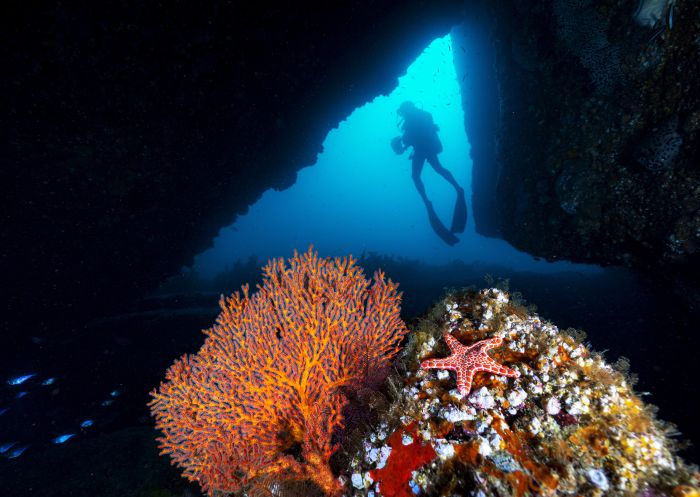
Scuba Diving, Jervis Bay - Credit: Jordan Robins
The wreck of the ex-HMAS Adelaide is just six minutes boat ride from Terrigal Beach on the NSW Central Coast, and is one of Australia’s most accessible wreck dives.
Scuttled in 2011, the ship's level, colours of encrustation and marine life (thriving on an artificial reef) is impressive. As you explore this enormous, intact wreck, you’ll be joined by clouds of fluttering of hula fish, large schools of mado, kingfish and yellow striped scad, and sitting silently on the rails, blennies and hawk fish watch you pass by. There’s bigger stuff, too: eastern blue groper, banner fish and even batfish.
For divers that have never penetrated a wreck before, you simply cannot beat a wreck that has been purposely scuttled for divers. Wherever you are inside, you can always see light and therefore an exit point, a very reassuring feeling. In the wheelhouse the various instrument dials and telephone receiver are still in situ. The telephone is probably the only part of the wreck yet to be covered in growth, no doubt a result of the number of divers simulating being on the phone underwater for a photo opportunity.
At 138m long and sitting deep on the ocean floor at 32m, limited bottom time at that depth means a single dive does not do it justice, so it is best to plan at least two.
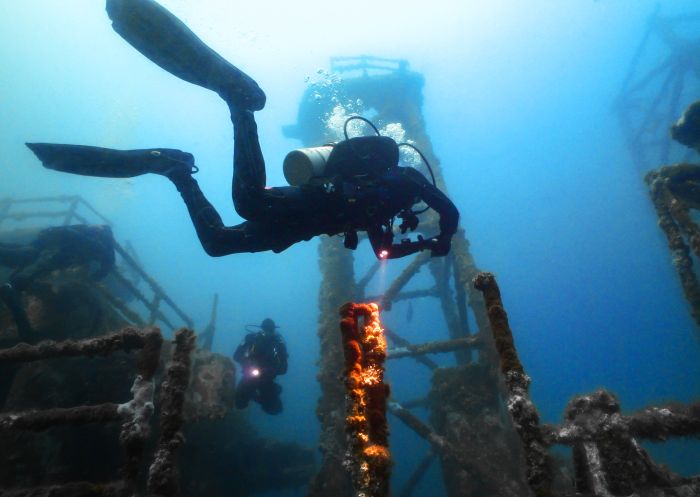
HMAS Adelaide, Toowoon Bay - Image Credit: Nays Baghai
No more than half an hour boat trip from the marina in South West Rocks on the NSW Mid-North Coast is a tiny unsuspecting island. It blends in perfectly with the surrounding coastline; rocky, jagged, and completely isolated. This is the home of Fish Rock, one of Australia’s best dive sites and home to a large aggregation of the critically endangered grey nurse shark.
The island isn’t huge but there is a lot more than meets the eye beneath the water’s surface: a mixture of sharks, rays, turtles and huge schools of fish. At certain times of year, large schools of hammerheads are also seen here.
The feature that all visiting divers talk about, however, is Fish Rock Cave. The cave runs straight through the island, with a small entrance at 24m depth, with a narrow passage that ascends to around the 12m mark. Here, it opens into a ‘bubble cave’, which gradually widens as you approach a broad entrance and beyond into a shallow gully called, somewhat appropriately, 'The Aquarium'.
It’s not just the adrenaline rush of diving through a narrow sea cavern that makes this dive exciting - it’s the abundance of life within. In the cave, you’ll glimpse crayfish and moray eels peeking out from crevasses, while stingrays and wobbegong sharks blanket the floor, and fish of all colours, shapes and sizes surround you. At the entrance to The Aquarium, the silhouettes of several grey nurse sharks hove into sight as you exit the cave and ascend through enormous schools of big eyes and stripeys.
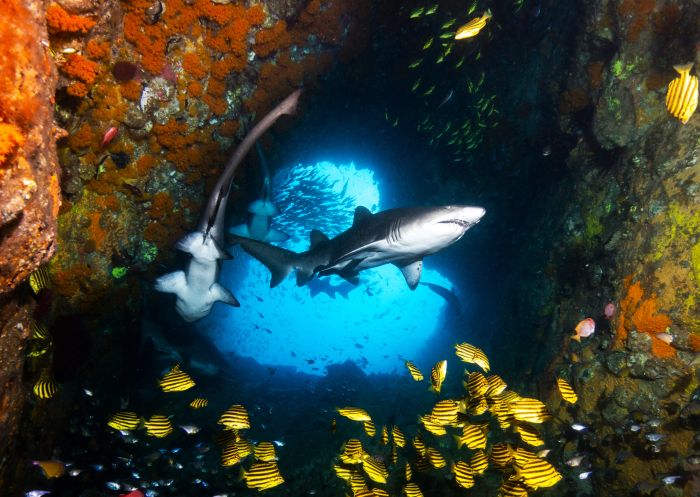
Fish Rock entrance Grey nurse sharks, South West Rocks - Image Credit: Matt Krumins
The Solitary Islands are located on the NSW Mid-North Coast between Coffs Harbour and Grafton, and what makes these islands so special is their proximity to the East Australian Current, which brings with it warm water and tropical species.
The result is a unique mix of temperate and tropical species, meaning you can expect to see everything from grey nurse sharks and wobbegong to leopard sharks and manta rays; below you, rocky outcrops are blanketed with plating hard corals, colourful sponges, anemones and vibrant soft corals.
North Solitary Island is particularly famous for its enormous beds of anemones and colourful pink and purple soft corals, while at Northwest Solitary Island, during the warmer months of summer and autumn you are almost guaranteed an encounter with manta rays.
In the gutters and gullies of the South Solitary Islands you come across large schools of grey nurse sharks, wobbegongs, shovelnose rays, eagle rays... and the odd hammerhead, leopard shark and Port Jackson shark.

Northwest Solitary Island manta - Image Credit: Deborah Dickson Smith
Julian Rocks is a pair of small rocky outcrops located 2.5km off the main beach at Byron Bay on the North Coast of NSW.
The site’s subtropical location is near the southern extent of range for lots of warm-water species, including exotic tropical macro-critters such as the ornate ghost pipefish and larger creatures such as loggerhead turtles, leopard sharks and manta rays. The warm water also provides a northern holiday for cool-water critters like grey nurse sharks. It’s a transit area for migratory species, as well as home for hundreds of residents.
Forming a small part of the Cape Byron Marine Park, Julian Rocks has been fully protected from fishing since 2006. More than 100 species of nudibranch have been identified here, but it’s the diversity of sharks and rays that form the primary attraction for divers, with over 20 species found here, including rarities like the Colclough’s shark and three species of wobbegong. In fact, shark biologists claim the abundance of sharks at Julian Rocks is the highest seen anywhere in the world in temperate waters.
Late summer tends to have the warmest water, best visibility and large numbers of tropical sharks and rays. But it’s a great dive year-round, with large numbers of grey nurse sharks encountered mid-winter, accompanied by the sound of whale song from migrating humpbacks.

Julian Rocks, Byron Bay
Off the coast of Fingal Head, close to the Queensland border, is a small rocky island swarming with subtropical marine life. Named Cook Island after the famous English explorer, the island was once known as Turtle Island, as its rocky reefs are home to a very large population of friendly turtles.
Located 600m offshore, Cook Island is easily accessible in a quick run out from the Tweed River. All around the island are rocky reefs in depths from 5m to 20m, with the Northern Ledges one of the best places to see numerous turtles. On the top of this wall are coral gardens, sea anemones full of anemonefish, abundant small reef fish and countless green turtles. Turtles gather in this area to get cleaned, and it is common to see a dozen or more lingering in the shallows.
The boulder wall is where most divers spend their time observing moray eels, wobbegongs, crayfish, bullseyes, gropers, leopard blennies, blind sharks, boxer shrimps, pipefish, lionfish and even pineapple fish.
While many divers stick to the wall, the sand flats beyond are worth exploring as many rocky outcrops provide a home to large and small marine life. This area is a good place to see wobbegongs, blotched fantail rays and shovelnose rays. In summer, leopard sharks gather here and can be seen resting on the bottom. A closer look on and around the rocks will reveal flatworms, nudibranchs, scorpionfish, velvetfish, cowry shells, ghost pipefish, mantis shrimps and the occasional seahorse.
Diving Cook Island is possible at any time of the year, with visibility typically 8m to 15m.
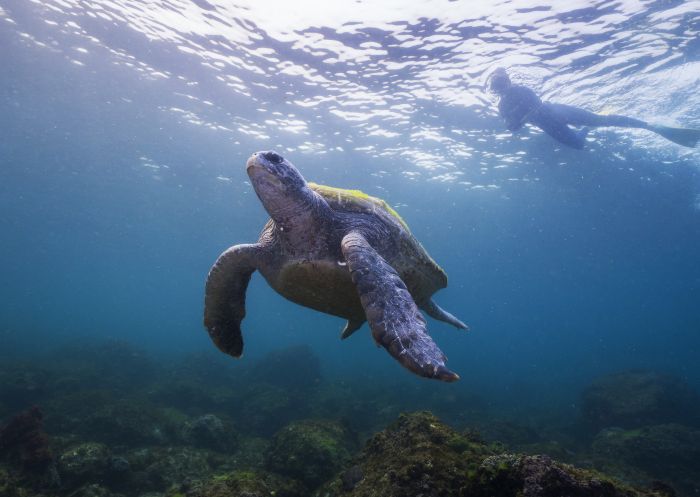
Cook Island, Fingal Head
Stay connected to Visit NSW for all the latest news, stories, upcoming events and travel inspiration.
All the insider news, tips and inspiration you need to plan your next trip, delivered straight to your inbox.
Sign UpVisitNSW.com is the official tourism site for Destination NSW.
© Copyright 2025 Destination NSW. All rights reserved